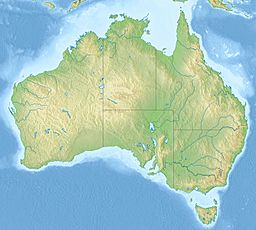Yan Yean Reservoir facts for kids
Quick facts for kids Yan Yean Reservoir |
|
|---|---|

The Yan Yean Reservoir with Whittlesea in the foreground
|
|
| Coordinates | 37°33′S 145°08′E / 37.550°S 145.133°E |
| Type | reservoir |
| Primary inflows | Toorourrong Reservoir via aqueduct (off stream storage) |
| Primary outflows | Plenty River |
| Basin countries | Australia |
| Water volume | 30 mio m³ (30,000 ML) |
The Yan Yean Reservoir is a very important water source for the city of Melbourne, Australia. It was the first large water supply built for Melbourne. When it was finished in 1857, it was the biggest man-made water storage in the world!
This huge reservoir is about 30 kilometers north of Melbourne. It was built on the Plenty River, which flows into the Yarra River. A large wall, about 9.5 meters high, holds back 30,000 million liters of water. The reservoir is managed by Melbourne Water. It is a key part of Melbourne's water system.
Contents
History of Yan Yean Reservoir
The name "Yan Yean" comes from an Aboriginal leader. His name was "Yan Yan," which means "young male." He signed an important agreement called Batman's Treaty in 1835.
Building the Reservoir
Work on the reservoir started on December 20, 1853. Governor Charles La Trobe began the project. Building it took place during the exciting gold rush period. About 1,000 workers, many coming from the goldfields, lived in a tent city nearby.
The project took four years to complete. It cost a lot of money, around £750,000. Some records say it cost even more, about £1,017,087. Most of the pipes used were brought all the way from London.
The main designer was James Blackburn. He was an English civil engineer. He had moved to Melbourne in 1849.
Water Supply Challenges
At first, the reservoir got its water from the Plenty River. But the water quality was not very good. This was because of farm animals crossing the river and pollution from nearby towns.
To fix this, a new plan was made. Water was brought from Wallaby Creek and Silver Creek instead. These creeks start in the Great Dividing Range. They feed into the Goulburn River. This clean mountain water was collected in the Toorourrong Reservoir system. This system was built between 1883 and 1885. It still sends water to Yan Yean today through a special channel called an aqueduct.
During the building of the Toorourrong system, a nearby area called Morang grew quickly. It was renamed South Yan Yean, and later became Mernda.
A World Record and City Growth
When the Yan Yean Reservoir was finished in 1857, it was the largest man-made reservoir on Earth. Melbourne's population had grown to 100,000 people by then. The reservoir officially opened on New Year's Eve in 1857.
The area around the reservoir has faced floods many times. In 1923, a big flood hit Melbourne. The reservoir was strong enough to handle it. It became the city's main water source during that emergency. In 1871-72, there was a very dry period. Water levels in the reservoir became low, making it hard to supply water to the city. During the Second World War, the area where the water was collected was closed for safety reasons.
About the Reservoir
The Yan Yean Reservoir is located 183 meters above sea level. This high position helps water flow easily through pipes to the city below. The dam wall is 963 meters long. The reservoir can hold 30 gigaliters of water. The area that collects water for the reservoir covers 2,250 hectares.
Many animals live around the reservoir. You might see wombats, sea eagles, hawks, ducks, and deer.
Fun Things to Do
Yan Yean Reservoir Park is a great place to visit. It has picnic areas and barbecue spots. There are also walking tracks where you can enjoy views of the reservoir and the mountains.
The wetlands area is popular for birdwatching. You can spot many different types of birds here. Some of them include the Musk Duck, Australasian Grebe, Great Crested Grebe, White-faced Heron, Dusky Moorhen, Eurasian Coot, Latham's Snipe, Musk Lorikeet, Eastern Rosella, Superb Fairy-wren, Red Wattlebird, Grey Butcherbird, and Grey Fantail.
See also
 In Spanish: Embalse Yan Yean para niños
In Spanish: Embalse Yan Yean para niños





